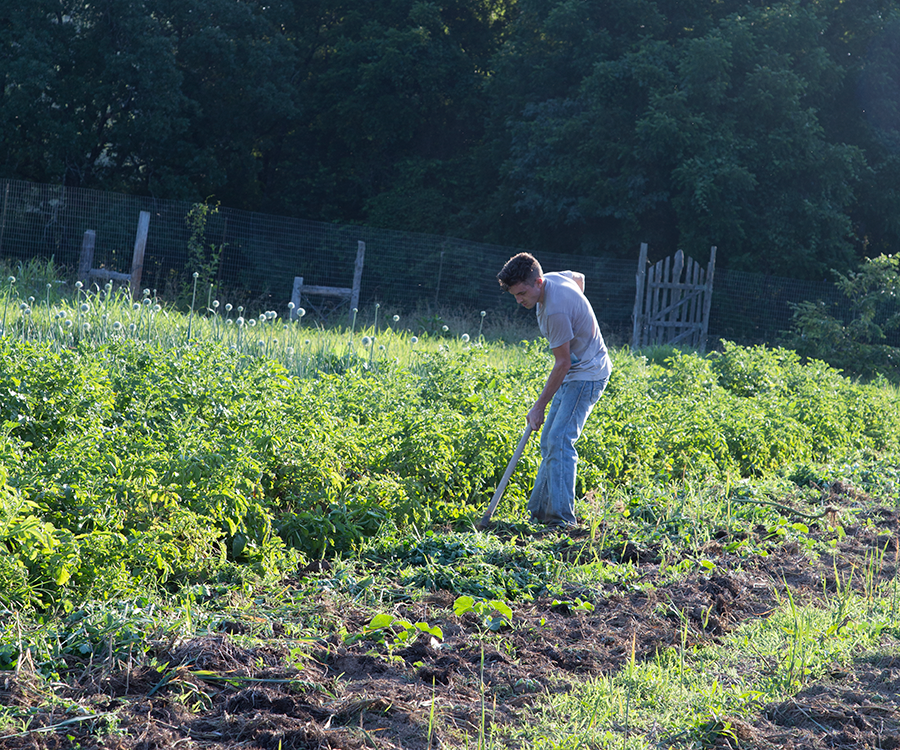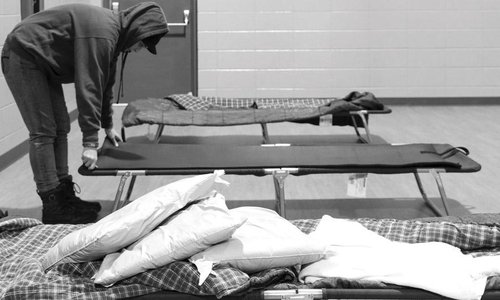Longform
Inside East Wind, Tecumseh's Intentional Community
Supported by a multi-million-dollar nut butter business, an intentional community has quietly existed in Tecumseh for more than 40 years. We sent a writer to find out about this slice of counterculture in our own backyard.
Written and Photographed by Vivian Wheeler
Sep 2016

Editor’s note: To respect the values of the East Wind community and the individuals who have chosen new names to reflect their identities, sources are identified by their first names only.
Ryn moved because she graduated from college at the start of the recession. Taralynn joined because her bipolar disorder can make it hard to function in a 9-to-5 job. For Sumner, he saw it as an opportunity to explore his interests. It was Deborah’s way to escape the culture of her parents’ generation. For my brother, Boone, it was the best way he knew how to fight for a better future. There are as many reasons for moving to East Wind as there are people living at East Wind—about 73 currently—but for everyone I talked to, it centered around the idea of a way of life that valued experiences over possessions and people over profit. There you’ll find a simpler life, one unbridled by the constraints of bills and appointments and paychecks and traffic jams and alarm clocks.
East Wind is an egalitarian intentional community in Ozark County. It sits just a few miles north of the Arkansas border in Tecumseh, Missouri. East Wind was a part of the back-to-the-land movement in southwest Missouri due to the affordability of land. It was established in 1974 after its sister community, Twin Oaks, reached capacity. Today, East Wind and Twin Oaks, along with a handful of other communities, comprise the Federation of Egalitarian Communities (FEC), which means the communities hold their land, labor, income and other resources in common.
Multiple greenhouses on the East Wind property help extend the growing season and provide year-round produce for the members.
Getting to the Commune
In the ’60s and ’70s, thousands of communes were started across America. Few of them are still standing today. East Wind is not only standing but also thriving thanks to two businesses, a nut butter–making business and a rope sandal business. The nut butter business alone netted just more than $540,000 in sales in 2015, and projections are even better for this year. In the history of East Wind, there have been dips in membership, but for the past four years, the community has continually run a waiting list. I wanted to see firsthand how this place functioned and to meet the people living there. I wanted to peek behind the proverbial curtain and see what life was like.
My brother had been interested in communal living for years. Last summer he broke up with his girlfriend, quit his job and drove from Princeton, New Jersey, to Springfield. He made it to East Wind, where he began his three-week visitor’s period, a trial run required for all prospective members. After that, he went on the waiting list, as East Wind was at its population capacity, which meant it was back to Springfield with me for a few months. Then in January of last year, he got the email that his spot was available. He’s been living there ever since, and in June I decided it was time to visit.
To be honest, my trip wasn’t entirely driven by a desire to visit my brother. I was more than a little curious to explore this enclave of counterculture. It was hard to believe that such a successful example of communal living was right here in 417-land.
Andrea, a recent college grad, works in the garden during her visitor’s period.
Life at East Wind
East Winders refer to the outside world as Babylon, which, by default, makes the community Zion. As I turned off of Highway 160 and onto a gravel road, I was officially no longer in Babylon. Pulling into East Wind, I was struck by how beautiful it was. I had seen pictures, but they didn’t compare to the real thing. East Wind encompasses almost 1,200 acres, more than 800 of which serve as an unofficial nature preserve with another 345 acres holding infrastructure, gardens and pastures. Lick Creek winds its way through the property, providing several idyllic swimming holes.
Nari plays the accordion in front of Rock Bottom.
It was dinner time when I arrived. I joined my brother and his fellow communards—cos for short—for a meal at Rock Bottom, the building that houses the kitchen and serves as the most popular hangout spot. In addition to Rock Bottom, several other buildings dot the community. The Music Room is not actually a music room, but another hangout spot that’s frequented by many of the long-term members. Then there is the actual music room. It doesn’t have an official name, but it’s filled with instruments. Foopin is the food processing building. Nuts Butts is the nut butter factory. Hammocks serves as the office building, computer room and community meeting space. Commie Clothes is the community’s closet. There’s the Man Hut, where male visitors stay, and Sunburst, the female counterpart, where I would be staying during my visit. After settling into my room, I fell asleep surprisingly fast considering it was June and there was no air-conditioning.
In the morning I woke up and headed to Rock Bottom in search of coffee. My days at East Wind would all start like this. I would pour a cup of coffee and then check the day board to see if anyone had posted work that needed to be done.
As a guest of my brother, I technically wasn’t required to work; however, I wanted to get a taste of what daily life was like, so I committed myself to trying to meet work quota. Quota is 35 hours during most weeks, reduced to 27 hours during holiday weeks, which happen once a month. For the most part, people can fill their work quota however they wish, and the possibilities are numerous. Just about anything that benefits the community can count as work.
Members and visitors are required to find work to do on their own. This was more challenging than I expected. My brother was also less help than I thought he was going to be. He was surprisingly busy and quite industrious, which was a bit of a departure from the time he spent living with me. He told me just to ask around to see what needed to be done. I learned there was always work to be done in the expansive gardens. I weeded tomatoes and mulched cucumber beds. Herb processing was another job that was never finished. There were two herb gardens, and they were full of peppermint, bergamot, chamomile, feverfew, Echinacea, holy basil and other plants that would be used to make medicinal tinctures. I wiled away more than one afternoon sitting under the natural gazebo made of wood beams and covered in wisteria while I picked leaves off of peppermint plants and tiny white and yellow flowers off of chamomile stalks. Through working I found out pretty quickly that I packed wrong for the trip. I had packed mostly athletic shorts, but I should have brought comfy, lightweight skirts, which is what most of the women wore because it’s easier to pee in the woods when you don’t have to pull down your shorts.
The bathroom situation took a little getting used to. The bathrooms are called Filmores, named for the last president to not have a flush toilet, and they work on a composting system. Buckets and peanut shavings replace toilet bowls and water. The buckets are collected and replaced each day, and the waste is composted for three years then used to fertilize the gardens and orchard.
The first time I tried to make use of a Filmore, I quickly abandoned ship. This particular bathroom had curtains instead of doors, and when I realized there was someone using one of the stalls, I chickened out and pretended that I just needed to grab a paper towel.
The East Wind community has a dairy and meat cow program. The dairy cows get milked every morning.
When I wasn’t working or trying to find an unoccupied Filmore, I spent a lot of time at the creek. I usually went swimming by myself. Most people swim in the nude, and as much as I wanted to embrace the full East Wind experience, I wasn’t ready to swim naked in broad daylight with a bunch of people I didn’t know. One day it was particularly hot and I decided to go for a swim in my birthday suit. I grabbed a couple of beers and a towel and walked to the swimming hole farthest away, thinking I would be safe. I disrobed at the bank and splashed into the water. I was halfway through my second beer when a group of four people showed up to enjoy the water. Camped out between my clothes and me, the group relaxed and chatted. Periodically they would swim and we would talk. As the sun got lower in the sky, my feet and hands started to turn into prunes, but I was determined to outlast them. As free-spirited as I consider myself, I could not imagine walking out of the water—completely nude—to put on my clothing. Eventually they headed back up the hill and I was able to get out of the water.
As I was putting my clothes back on I realized the only thing that seemed out of the ordinary for the group of people I was swimming with was probably how long I was in the water. Nudity anywhere at East Wind is not unusual, and by the end of week I didn’t think twice about. As I was walking back up to Rock Bottom, I couldn’t help but think how quickly different cultural differences start to feel normal. I ran into my brother who was just finishing up a shift in the nut butter factory. They had gotten in two $60,000 orders that week, and things were busier than usual.
Getting Down to Business
The nut butter business produces organic and regular peanut butter, cashew butter, almond butter, organic tahini and plain packaged peanuts. East Wind Nut Butters can be found all over the Midwest in a variety of stores. You can even find them in certain Walmarts. What members are required to perform each week depends on demand and is set by the production managers, but it typically ranges anywhere from zero to nine hours a week.
Member Virgil works filling jars with almond butter in Nut Butts, the nut butter production factory.
Members turn in their hours each month on a scoop sheet, and hours are recorded by the labor manager. If a member falls too far behind on their hours, they can face expulsion. While I was visiting, a preliminary member, Mouse, fell more than 115 hours in the hole, which according to the bylaws meant automatic expulsion.
I’m not sure why Mouse chose his name, but it seemed to be fitting. Mouse is soft-spoken and shy. He has short, blond dreadlocks and is rarely seen without sunglasses on. Having not yet lived at East Wind for a year, Mouse wasn’t a full member, but he stopped turning in his scoop sheets to protest the labor system.
“People don’t talk to each other,” he said. “I see the whole labor system as one of these avenues where people kind of use these rules and regulations to hide behind so they don’t have to talk to each other.” He thought the scoop sheets were infantilizing and didn’t think they would be necessary if members were capable of directly communicating with each other. Mouse hadn’t actually stopped working; he had simply stopped turning in his scoop sheets.
A meeting was called, and about 40 people gathered outside of Rock Bottom. Members took turns speaking. Many of them expressed an acknowledgment of Mouse’s objectives, and some people even said they would also like to see the labor rules revisited, but almost everyone who spoke mentioned how they did not appreciate the way Mouse was going about things. They didn’t like that he was simply refusing to follow procedure. They felt he should work within the system to change things. By the end of the meeting they decided to give him a week to get a petition passed. I recently asked my brother what happened. It turned out Mouse’s petition failed and he ended up leaving.
Members gather outside of Rock Bottom for a meeting to discuss Mouse’s labor deficit.
Meeting the Members
Despite the outcome of Mouse’s labor dispute, very few members actually get kicked out of community. When people leave, it’s typically because they want to. Even in the meeting, it was evident that most people wanted to figure out a way Mouse could stay. I heard from multiple people during the week that they believe in giving people second, or third or fourth, chances. Or, as one member put it: “East Wind will give you as much rope as you need. Just be careful not to hang yourself with it.”
A high value is placed on personal freedom at East Wind, which is interesting considering the nature of the place. There have even been scholarly pieces written about the interplay between the individual and the community at East Wind. For most us, part of living a happy life means finding your perfect balance between freedom and security. For Deborah, one of the 16 founding members and the only one currently living at the community, East Wind offers her the maximum of both. “The amount of security I get for the amount of freedom I get, that ratio can’t be beat anywhere else I lived or anywhere else I’ve ever heard of,” she says. “I have more freedom here than I could have anywhere else in this country. And certainly as much security.”
A hammock by the creek is a popular destination for warm-weather napping.
Part of that freedom means being able to create a new identity. Many members change their name when they come to East Wind. While I was there I met a Sage, an Earth Pig, a Luida, a Willow, a Faye, a Mandar and even a Mr. Poopy Butthole. People will change their names depending on their mood. One member, Taralynn, posted a note on the day board while I was visiting that explained she would like to be called Mirror. And people respected her request for a new name.
I asked Ryn, a woman who has been living at East Wind for five years, why she thinks so many people change their names. “A lot of people come here, and they discover new things about themselves, or they grow quite a bit over the first year or two of their membership,” she says. “It’s part of that process of truly being able to define yourself as opposed to being defined.”
Ryn has defined herself as one of the hardest workers at East Wind. As the food production manager, she’s in charge of a whole slew of duties that range from putting up garden vegetables and processing meat to making cheeses and drying herbs. She has a shaved head, thick glasses and an accent I’ve never heard before. Her speech is peppered with folksy colloquialisms that belie her intense intelligence. Originally from Maryland, Ryn graduated from Oberlin College in 2010, and moved to East Wind shortly after. She’s 28 years old, and I as sit across from her, it’s hard not to compare myself to her.
I also graduated from college in 2010. I am also 28 years old. If this were a Shakespearean play, we would be foils: our superficial similarities serving to highlight our stark differences. Her skills read like a laundry list of meaningful and useful knowledge: woodworking, blacksmithing, canning and preserving food, animal husbandry and farming. The last new thing I learned was how to use Snapchat, and I’m not even very good at it.
Bert, an East Wind member for more than 20 years, also values the personal freedom East Wind allows him and uses much of his free time to create math-inspired art, examples of which can be seen across the property. Moving to East Wind strained his relationship with his family, but he has found a family in fellow communards. “These are wonderful people,” he says. “There’s a genuine interest and compassion for each other that is here that I don’t think you find universally outside East Wind. When somebody falls or stumbles here, they’re quick to pick you up, metaphorically.”
Coming Back to Reality
Not everyone is so lucky. Sixteen percent of people in southwest Missouri are food insecure, a fact that seems almost unbelievable in this day and age. And Ozark County is one of the poorest counties in Missouri. According to the United States Census, almost 21 percent of the people fall below the poverty line. Ozarks Food Harvest works with local food banks to help alleviate some of the need for food, and twice a month East Wind sends volunteers to assist. One morning while I was there, I piled into a large white van with four other people from East Wind and drove to a defunct factory that now serves as a temporary food bank.
We spent four hours filling boxes with canned vegetables and fruit, Jif peanut butter, boxes of packaged dinners, dried beans, Eggo waffles and frozen chicken. People drove up in their individual cars and stood in line, waiting to check in and pick up their allotments. One lady had a walker, so I helped her out to her vehicle. Her car clock read 12:07. I thought of everyone back at East Wind. It was lunch time. People would be filling up on fresh veggies, organic meat and raw milk. They would be dining on non-GMO millet and gluten-free noodles. I slid the box into her back seat and told her to have a good day.
Sometimes I feel as if the great joke of life is the fact that we live in a world where we have enough resources to feed everyone and yet there are people starving to death while others throw away perfectly good food. I understand that, for a whole slew of complicated reasons including, but not limited to, logistics, politics, geography, cultural norms, ad infinitum, this is not a simple issue to fix. But still, this sense of injustice sits right below the surface of everyday life for me. It’s like a constant itch that I can ignore most of the time, but when I start to scratch it, it becomes incessant and acute. And I scratch it until I become exhausted, and then I go back to ignoring it, resigned and helpless before its towering enormity.
For the week I was at East Wind I didn’t feel helpless. I realized it was the first time in my life I could be positive that every person I met had a safe, dry place to sleep and enough to eat. Heading back to Babylon would mean air-conditioning, plumbing, restaurants, my own shower and all the creature comforts I love. But it also would mean going back to a world where not everyone has enough to eat or a somewhere to live. I wasn’t sure the trade-off was worth it.




















